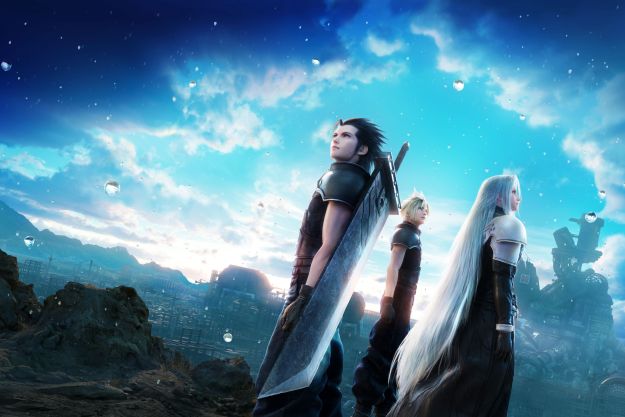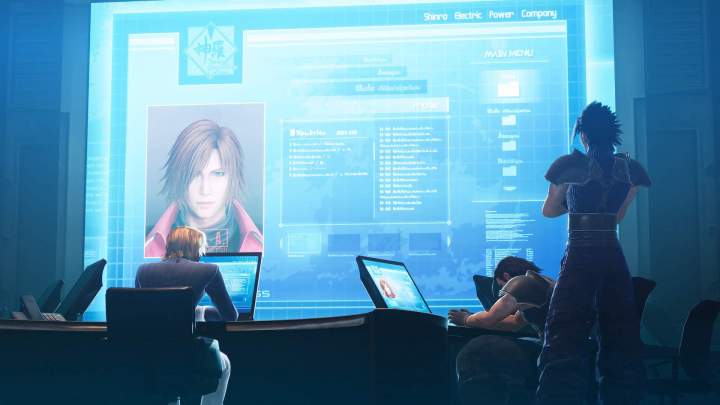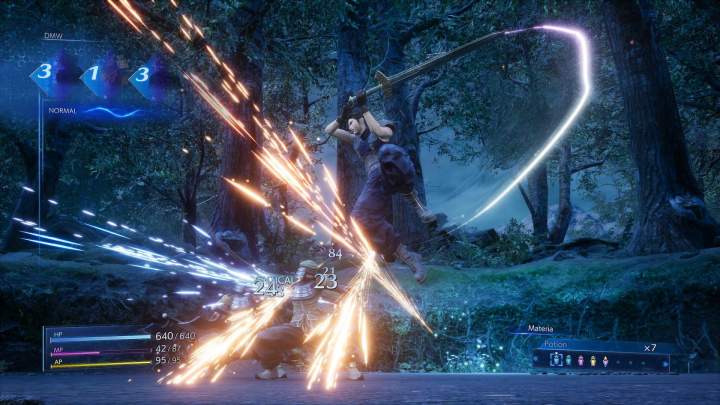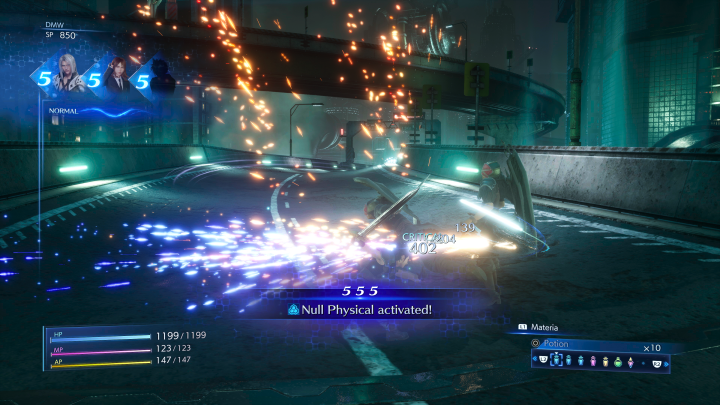
“Crisis Core: Final Fantasy VII Reunion looks like a modern game, but its aged PSP gameplay doesn't match the HD overhaul.”
- Still a compelling story
- Intriguing DMW system
- Strong RPG customization
- Welcome visual and audio tweaks
- Repetitive combat
- Tedious side missions
- Dated feel overall
If you walked away from 2020’s Final Fantasy VII Remake wishing for a more faithful modernization of the classic RPG, then the by-the-books Crisis Core: Final Fantasy VII Reunion is for you.
Square Enix’s latest revisit is a safe preservation play, as if built to throw purists a bone. It takes 2007’s Crisis Core, a PlayStation Portable-exclusive prequel to Final Fantasy VII, and freshens it up with some new visuals, quality-of-life improvements, and a few tweaks to create parity between it and FF VII REmake. It’s not an ambitious reimagining that’s going to surprise players with narrative twists or extra content. I imagine that’ll be music to some fans’ ears, but there’s a simple reality that comes with a restoration project like this: a new coat of paint only does so much when it’s covering up growing mold.
Crisis Core: Final Fantasy VII Reunion offers a perfectly suitable way for fans old and new to experience a crucial chapter of the RPG series’ rich story. All of its upgrades are welcome and necessary additions for a remake as faithful as this; they just don’t do much to help an aging portable game whose flaws only stick out more when disguised with the illusion of modernity.
The core experience
As Square Enix embarked on its ambitious project to completely reimagine Final Fantasy VII, a Crisis Core rerelease became something of a necessity. The PSP game was previously a world-expanding prequel that could be entirely skipped, but its narrative now plays an important role in the remake universe’s future. That’s thanks to protagonist Zack Fair, who appears to have defied fate heading into the upcoming Final Fantasy VII Rebirth.
But I’m getting ahead of myself. To understand why that matters, you need to know Zack’s original story. That’s exactly what this version of Crisis Core provides, which makes it a fundamental success regardless of its ultimate ambitions.
Fifteen years later, Zack’s saga stands out for how complete it feels compared to most games of this scale released today.
Crisis Core’s story remains entirely unchanged in Reunion, timeline shenanigans be damned. Set seven years before FF VII, it follows the bright-eyed soldier Zack as he looks to make his way up the ranks of Shinra’s private army by hunting down a deserter named Genesis. As a prequel, the narrative always had the unenviable task of creating both a piece of connective tissue that would interest fans and a self-contained adventure that could hold up on its own merits. The former can be hit-and-miss. In its more eye-rolling fan service moments, Crisis Core goes out of its way to answer questions that no one was asking, like “How did Aerith get her flower cart?”
Other pieces are far more compelling, though. Its best scenes provide crucial context for the events of Final Fantasy VII, adding more depth to the villainous Sephiroth and giving Cloud Strife a heartfelt backstory that opens up his emotional range. Considering that we’re only one-third of the way through the current remake experiment, the new version of Crisis Core is particularly well-timed. It feels like less of a decade-late retcon in 2022 and more of a natural interlude in a story that’s unfolding over multiple releases.

Though it’s hard to divorce Crisis Core from Final Fantasy VII and assess it as its own tale, there is some standalone value in the narrative here upon revisit. Fifteen years later, Zack’s saga stands out for how complete it feels compared to most games of this scale released today. Since the original release was never intended as an open-ended franchise starter, Zack gets a full character arc that most game heroes just aren’t afforded these days. Though I sometimes found myself hoping I’d get some surprise payoff to Final Fantasy VII Remake’s shocking ending, I’m ultimately glad Square Enix stuck to the script here. Doing so let me focus on what’s actually moving about Crisis Core: the story of a young soldier learning that heroism is about sacrifices you may never be celebrated for, not fame.
Over and over
Though its story is timeless, its combat hasn’t quite held up as well — especially when placed next to the modern Final Fantasy games it’s reworked to look like. Hacking-and-slashing is largely a one-button affair that had me mashing my thumb down on my controller until it was sore. There’s a block and a roll to add a bit of defense, but the repetitive nature leaves battles feeling a bit flat overall.
A magic system helps alleviate that a bit, but it can’t fully solve those problems. Zack can equip up to six spells at a time, which consume either magic or ability points. Those can bring extra strategy to battle, especially thanks to a deep Materia combining system that adds extra RPG depth, but they largely wind up being just as one-note. When I come up against an enemy that has a clearly noted electricity weakness, I simply spam an electric slash attack until I run out of ability points. There’s not much incentive to mix attacks up, even in massive boss battles.
The flat combat just isn’t dynamic enough to justify so much repetitious padding.
There’s an extra layer on top of all of that, which is Crisis Core’s divisive Digital Mind Wave (DMW) system. During every battle, there’s something that looks like a slot machine pinned in the top-left corner of the screen. It auto-plays through battles, trying to match up images of characters Zack has interacted with and numbers. When the slots line up correctly, Zack can activate limit breaks, use summons, or get buffs like invincibility for a short time. Its pros and cons are equal. It takes a lot of control out of players’ hands, which is why Zack’s moveset winds up feeling so sparse. Even leveling up is frustratingly at the mercy of random spins (though there’s a logic to when that triggers).
At the same time, DMW works as a high-concept idea — something that recent Final Fantasy games have really dialed into. Crisis Core is a game about fate, starring a character whose path was decided well before the game even launched. Having Zack be at the mercy of the universe’s random number generator fits with his journey. When you accept that idea for what it is, combat becomes more palatable. Zack’s actions become directed by an unseen force, granting him buffs that he has to capitalize on. When the wheel tells me spells are free for a short time, I take advantage of that moment to heal up and unleash as many spells as possible. When it tells me I’m impervious to physical damage, I fearlessly lay into my enemy. It’s what I’m destined to do.

Even so, the combat system still feels too thin to sustain the entire experience, especially when it comes to subquests. Reunion features around 300 side missions, which are nearly identical in nature. Each sends players on a short dungeon crawl where they have to defeat a few enemies, with very little variation. They’re incredibly tedious, but key upgrades like additional item slots are locked behind them. The flat combat just isn’t dynamic enough to justify so much repetitious padding.
The main story missions at least have a little variety with quick minigames here and there, like a robot sniping section, though even those are fairly simple interludes. The most fun I had in Reunion came in menus when I was crafting powerful Materia or optimizing my accessories. None of that really made a difference once I jumped into battle though.
Remake or remaster?
When going into an older game, I always come in with my expectations calibrated accordingly. I don’t load up a Sega Genesis game and assume it’ll have the modern improvements of a Nintendo Switch title. That expectation shifts, however, the more the game is packaged up to look modern. If something looks like it was made in 2022, but plays like it’s over a decade old, it can often leave a game feeling a little off. That’s the issue Square Enix runs into here.
It’s a chapter from a book stapled into a completely different one.
A lot of work has gone into upgrading Crisis Core for new consoles. Its visuals utilize assets from Final Fantasy VII Remake, giving it an immediate leg up. UI is improved across the board, with the DMW being much less invasive overall. The audio is especially a high point, with new voice performances to match Remake and fantastic new music compositions that make the experience feel much grander than a PSP game.
But it is a PSP game.
I don’t mean that in a derogatory way. Sony’s handheld contained plenty of excellent experiences (Crisis Core included), which took great care to make massive series work on a much smaller scale. The stripped-down combat and glut of quick sidequests were a good fit for the limited tech of the time. The reality, though, is that those design decisions are hard to divorce from the platform it was built for.

Part of the problem is that this version of Crisis Core feels stuck between a remake and a remaster. Its high-level visual overhaul makes it look like a ground-up remake of the original, but that’s a bit of an illusion. Its new assets are simply papering over the old ones, which really sticks out considering how dead-eyed characters are and how sparsely animated everything is. Square Enix very pointedly uses the words “HD remaster” in its marketing, but it’s hard to see it in that light when this is a project built to create parity with a wildly reimagined version of Final Fantasy VII. It’s a chapter from a book stapled into a completely different one.
Like Zack Fair, Crisis Core: Final Fantasy VII Reunion is at the mercy of its destiny. With no big-picture changes to its structure and gameplay, the remaster’s success is predetermined by how well its 2007 counterpart has aged. Reunion is a textbook translation of the original, which is fantastic news for historical purists who want to experience its standout story unaltered. Though for anyone who resonates with Final Fantasy VII Remake’s philosophy that the world is not a static place governed by fate, Reunion will stick out as an ideological counterpoint disguised as a compliment.
Crisis Core: Final Fantasy VII Reunion was tested on PC and Steam Deck.



